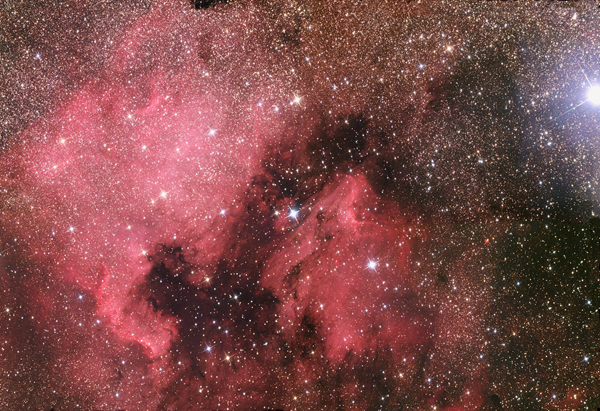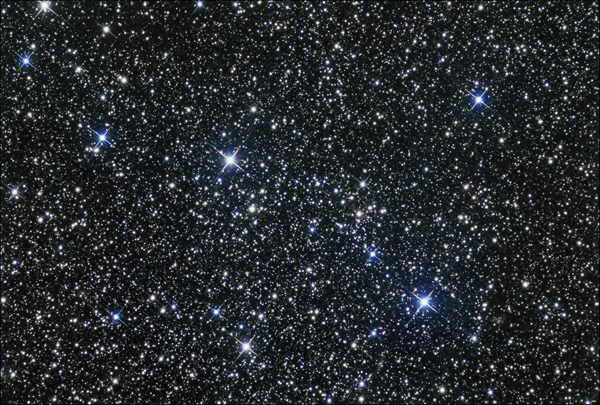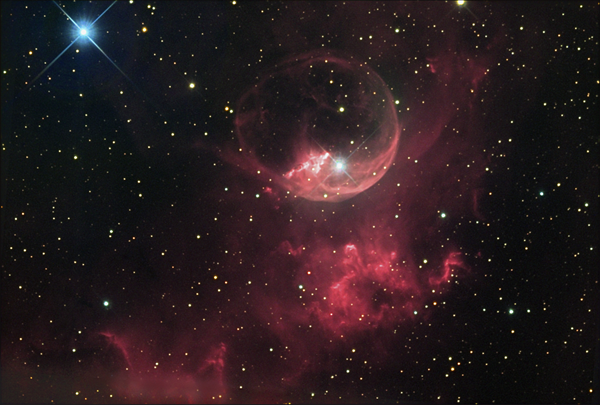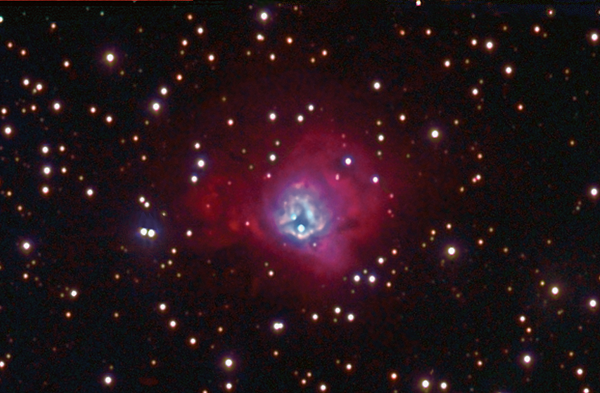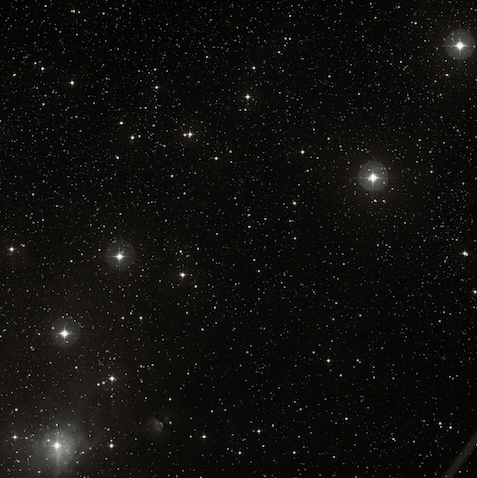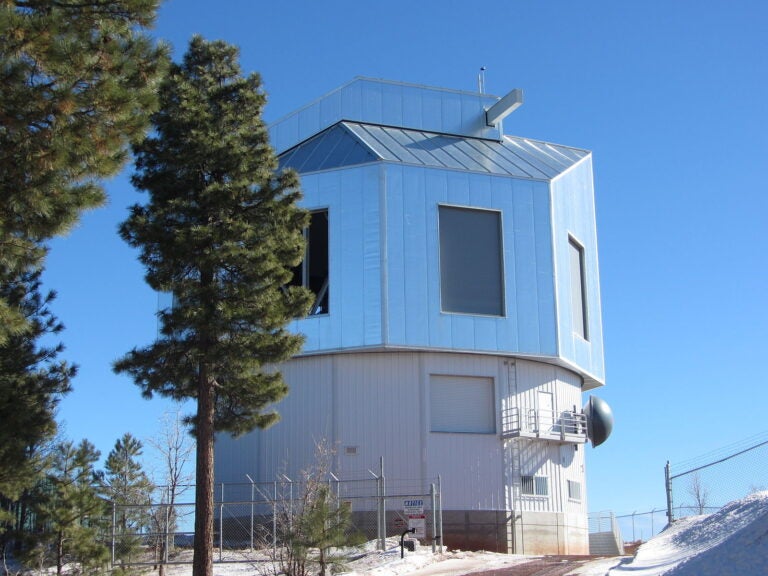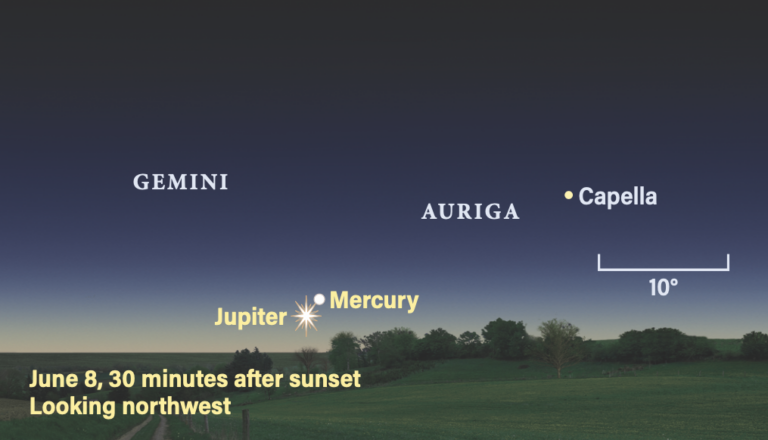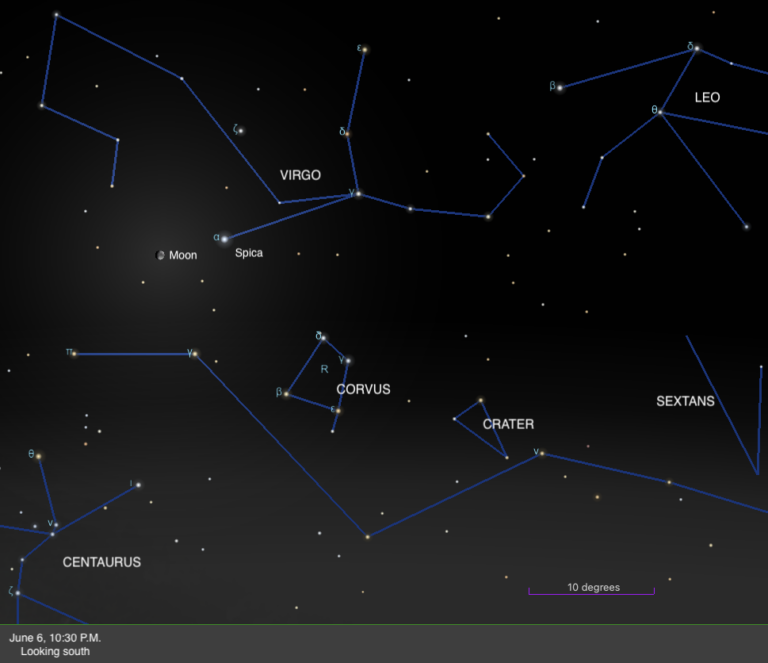Astroimagers may find some of the objects of particular interest because they are immersed in a rich wonderland of deep-sky objects normally beyond the limits of the eye. So enjoy the hunt — and the views.
Swan lake
Our first stop is a milky lake of celestial wonders east of Deneb in Cygnus the Swan. The North America Nebula (NGC 7000) is a wonderland unto itself. It lies only 1° west of 4th-magnitude Xi (ξ) Cygni and forms part of a large HII region some 2,000 light-years distant. Under a dark sky, unaided eyes can readily pull out the boxy glow representing Canada and the central United States, but you’ll need binoculars to see the entire continental outline. Through a telescope, use low power to see its countless suns scattered across a pale green glow, looking like scintillating gems emerging from a sheet of melting ice.
Return to Xi Cygni and move about 1¾° south to find the magnitude 8.5 planetary nebula NGC 7027, sometimes called the Pink Pillow. It’s one of my favorites. Although it’s visible in binoculars, the nebula requires considerable magnification (consider 100x per inch of aperture) to see details in its tiny 18″ disk. Don’t be shy, as this is one of the densest, and therefore youngest, planetary nebulae known. Look for a dumbbell-shaped glow oriented north-northwest to south-southeast, with the north-northwest side being the brightest; that section also contains a bright knot centered on the nebula’s northwestern edge. Large-telescope owners should look for the bright lobe displaying beautifully contrasting pink and green hues.
Return to Xi Cygni once again. This time, use your binoculars to sweep about 2° to the northeast, where you’ll find the magnitude 7.5 open cluster NGC 7039. This 15′-wide cluster lies about 3,000 light-years distant, and it is nestled in a 40′-wide butterfly asterism of about a half-dozen 7th- to 8th-magnitude stars oriented east–west. The young cluster is best appreciated in low-power telescopes, as its 100 or so members effervesce into the rich Milky Way background quite easily.
A gentle push 45′ northeast of the 7th-magnitude central star at the heart of NGC 7039 will bring you to planetary nebula NGC 7048. At 12th magnitude, this planetary should be a challenge to small-telescope users without a go-to mount, as it requires a dark sky, good star-hopping skills, and some patience. In images, the nebula displays a somewhat ragged but generally ringlike appearance with a diffuse halo extending roughly perpendicular to the ring’s major axis. Through a 5-inch scope, magnifications greater than 100x reveal only an amorphous circular glow of mostly uniform light with averted vision.
Slipping about 3° north-northwest, we come to the magnitude 4.5 star 63 Cygni, only 12′ north-northwest of which is another marvelously minute planetary nebula, the Cheeseburger Nebula (NGC 7026). Glowing at 11th magnitude, this 21″-diameter disk has a central ring structure with bipolar lobes on each side, giving it an amorphous butterfly appearance. Through a 5-inch telescope, I’ve used 180x to glimpse this shape, which is oriented roughly north–south. To see the cheeseburger (opposing enhancements along the ring) requires magnifications between 75x and 100x per inch of aperture. Again, the nebula is small and tight, so it takes power well.
A beautiful dark nebula, Barnard 361, lies about 1° east of 63 Cygni. Through a 5-inch scope, this 30′-wide stain in the Milky Way is rimmed by folds of scintillating starlight. Here you’ll find 12th-magnitude open star cluster IC 1369 — a whisper of dim starlight packed within only 5′ of sky about 30′ beyond the dark cloud’s northern edge, arranged like an afterthought.
An outpouring of deep-sky riches lies south and west from 5th-magnitude 4 Cassiopeiae. We’ll start at a visual wallopalooza: open cluster M52, a metaphorical “purple haze” of about 200 young suns ½° south of the star. Through 10×50 binoculars, the 60 million-year old cluster looks like a double star caught in a haze. Telescopically, it is a disco ball of tiny blue crystal chips, while thin wisps of faint stars jut from the globe like dust in a sunbeam.
Only 35′ to the southwest is the dauntingly dim object called the Bubble Nebula (NGC 7635), an even fainter ring of gas, whose brightest section abuts a 9th-magnitude star. While this object measures 15′ by 8′, the bubble spans only 3′ across. Through a 4-inch telescope, it is only weakly visible under dark skies. Although the Bubble resembles a planetary nebula, it is part of an HII region wherein ferocious winds from the 9th-magnitude star have sculpted the surrounding gas and dust into the shape we see today.
Less than 1˚ west-northwest of the Bubble Nebula, we find a miniature delight called the Little Lagoon Nebula (NGC 7538). This 9′-by-6′ emission nebula lies 9,000 light-years distant in the Cassiopeia OB2 association, which is rich in HII regions, dark clouds, young clusters, and reflection nebulae, so it is a gem for wide-field astroimagers. Telescopically, the lagoon appearance is lost, appearing only as a diffuse glow around two central stars with a knot of nebulosity to the southwest — but that’s where active star formation is occurring.
Less than 1˚ south-southwest of the Little Lagoon is the delightful Dormouse Cluster (NGC 7510). Although the cluster is relatively dim (magnitude 8) and small (7′), it features a prominent spearhead of stars within a longer squashed ellipse of slightly brighter suns. Use high power to enjoy this little gem, which contains about two dozen stars ranging in brightness from magnitude 10 to 13.
Continuing to the southwest, sweep less than 1° beyond the Dormouse to the challenging and highly neglected emission nebula IC 1470. This tiny (3′) glow shines dimly at 11th magnitude (the brightness of its illuminating star). Moderately large apertures and magnifications in the 250x range are required to pick out this piece of celestial lint. Look for a moist exhalation of gossamer light clinging to the star like a phantom dust bunny. In images, this nebula is also reminiscent of the Lagoon Nebula (M8). So we have two mini-lagoons within 1° of one another.
Within 3° of 3rd-magnitude Eta (η) Geminorum, we find six open star clusters, two nebulae, and one challenging supernova remnant. We’ll move counterclockwise from what I call the Peek-a-Boo cluster: Collinder 89.
Ever see this open cluster? Many do without even knowing. It forms an ellipse around the chain of stars between 9 and 12 Gem, about 1½° northwest of Mu (m) Gem, one of Castor the Twin’s toes. The cluster shines around 6th magnitude and contains 20 stars within a 1° circle — so, yes, it is huge! Use binoculars or low power (about 20x) in a telescope to see this large and loose elliptical cluster. Look for delicate spirals of stars lifting off the loose and scattered core, especially at the two ends. Relax your gaze to take it all in.
Don’t move a muscle because our next target is literally in the same field of view: reflection nebula IC 444. This haunting 30′ spirit of air veils 12 Gem (its illuminating star) and is one of those objects that confounds, as some have spied it in large binoculars, while others using moderate apertures have had difficulty. It’s reminiscent of nebulosity in the Pleiades (M45) — so think delicate and diffuse. Also be aware that visual observers will most likely detect only the brightest 10′ of it. The rest is best left for astroimagers.
Now loop over to four clusters between 1 Gem and 5 Gem (and slightly beyond). First up is the highly neglected open cluster NGC 2129. You’ll find this small (6′) open cluster less than 45′ west and slightly north of 1 Gem. Use 70x and higher to look for about a dozen suns coarsely scattered around a central triangle of 8th-magnitude stars. Larger scopes will triple the number of stars in that tiny area!
Hop over to 5 Gem and use your eyes or binoculars to spy M35, a 5th-magnitude open star cluster and one of the richest, most compact, and nearby open clusters. Some 200 stars or more are splashed across a 30′ field; its brightest members form a figure-eight pattern or corset of about two dozen suns that seem to hold in the cluster’s slender waist.
Sharing the same low-power view with M35 is the 8th-magnitude, pint-sized (5′) open cluster NGC 2158, just ½° southwest of M35. Now for the fun part: Although NGC 2158 appears smaller and dimmer than M35, the two clusters are really similar in physical size; it’s just that NGC 2158 is six times more distant.
Let’s drop southward to 5th-magnitude 68 Orionis, where, about 1° to the north-northwest we encounter NGC 2175, sometimes called the Monkey Head Nebula. This is one of my favorite hidden treasures of the night sky. This 40’-by-30’ swath of gossamer light in an extremely rich field of Milky Way includes the possible open cluster Collinder 84. A delight to see under a dark sky, it is visible in 7×50 binoculars; telescopically, especially at low power, it appears as a vast, irregularly round glow of pale uniform light with an illuminating magnitude 7.6 star at the center. Inside the larger nebula, on the northern side, an extremely faint wisp of nebulosity between three stars has its own NGC number: NGC 2174.
Before we close our tour with a bang, let’s return to our starting star: Eta Geminorum, a magnificent tight double made up of a magnitude 3.5 M-class giant with a blue 6th-magnitude companion 1.7″ distant. Once you’ve finished appreciating this highly neglected pair, get ready for what I would consider an ultimate challenge for moderate-sized and larger telescopes: supernova remnant IC 443, sometimes called the Jellyfish Nebula.
I have long looked for this challenging object with minimal success. I’ve definitely seen only the brighter northeastern component, with extreme difficulty, once through my 5-inch scope at 30x under the dark skies of Volcano, Hawaii, and once more dramatically through amateur astronomer Mario Motta’s 32-inch reflector in Gloucester, Massachusetts. This segment — a 10′-by-5′ comma of fantastically faint light (oriented northwest-southeast) 50′ northeast of Eta — represents one edge where the supernova’s expanding shock wave collided with a dense molecular cloud some 5,000 years ago. Use an Oxygen-III filter to help bring it out. The fainter tendrils of the jellyfish abut Eta to the northeast and lie in the same field, forming perpendicular ripples of light that best show in astrophotos. Indeed, wide-field astrophotos can capture the entire Jellyfish, reflection nebula IC 444, and open cluster Collinder 89 in a single field.
As you explore the winter sky, take time to note these amazing regions where unusual and myriad deep-sky objects cluster together. They just might give you a new appreciation for hunting deep-sky objects in the cold of the night.

